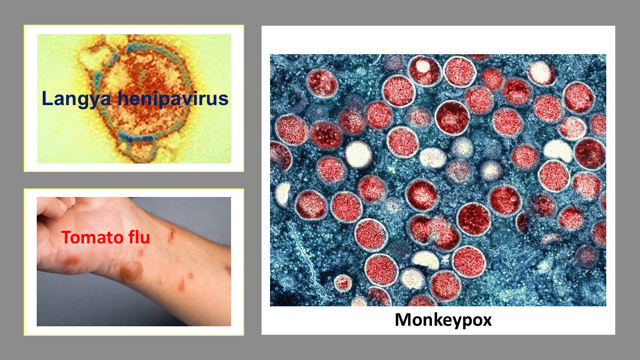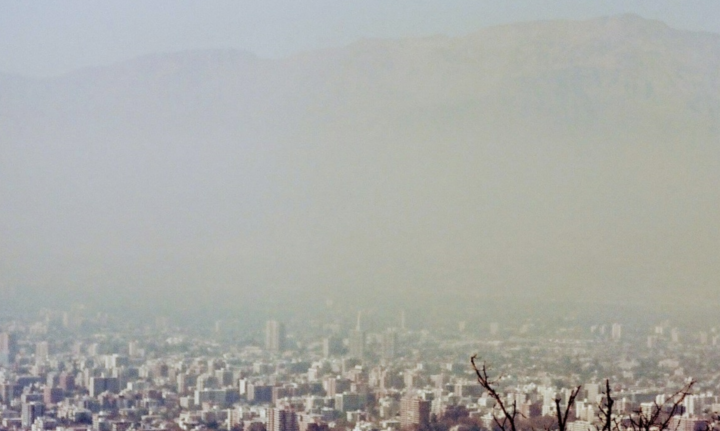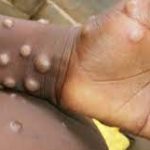When monkeypox initially came into public prominence with the first case outside of its endemicity reported in the UK on 6 May 2022, we all thought that the virus would fade away within a couple of months given its inefficient mode of transmission. Another reason for this casual optimism was also because the monkeypox virus is a DNA virus, and like other DNA viruses, it is better at detecting and repairing mutations than an average RNA virus, such as SARS-CoV-2. Therefore, chances of the virus mutating into variants and acquiring enhanced capability to spread and/ or become more lethal like SARS-CoV-2 was near impossible. But against all expectations, the virus has persisted and is now commanding more attention than ever.
Monkeypox, which is prevalent in West and Central Africa, is transmitted mostly through skin-to-skin contact. The disease since its first report in May 2022 (reported here on 29 May 2022), has now spread to 92 countries with 47,209 confirmed cases, according to the latest figures provided on 26 August 2023 by the US Centres for Disease Control (CDC). These countries are outside the monkeypox endemicity area and the spread in these countries is mostly amongst men who have sex with men (MSM), especially those that are promiscuous and engage with multiple sexual partners. Of the 47,209 confirmed cases outside of the monkeypox endemicity, more than one-third occur in the USA with the states of New York, California and Illinois accounting for half of the cases.
On Monday 22 August 2022, the Wyoming Department of Health announced its ever-detected case of monkeypox, which meant that the monkeypox virus has now been detected in all 50 US states with a total of 17,432 reported infections, the highest toll in the world as of 26 August 2022. The governor of New York State, Kathy Hochul, on Tuesday, called on the Biden administration to accelerate the shipment of monkeypox vaccine to the state where over 90% of the US cases have been identified.
Since monkeypox came into public prominence this year, only six fatalities outside of Africa had been recorded, including in Spain, India, Ecuador, Brazil and Cuba. Spain recorded two confirmed deaths from monkeypox, and the rest, one confirmed death, respectively.
Inside Africa, 443 confirmed cases of monkeypox have been reported in 7 countries as of 26 August 2022. These countries are Benin, Cameroon, Central Africa Republic, Democratic Republic of the Congo, Ghana, Liberia, Morocco, Nigeria, Republic of the Congo, South Africa, and Sudan. Of these cases, 7 fatalities had been recorded in 3 countries, these are: Central Africa Republic, Ghana, and Nigeria with 2, 1, and 4 deaths, respectively.
On 23 July 2022, the World Health Organisation declared monkeypox a public health emergency of international concern (PHEIC), and the USA too, was not far behind in declaring the disease a US public health emergency on 4 August 2022.
The World Health Organisation Director-General, Tedros Adhanom Ghebreyesus, said in his declaration, “We have an outbreak that has spread around the world rapidly, through new modes of transmission about which we understand too little. …. Although I am declaring a public health emergency of international concern, for the moment this is an outbreak that is concentrated among men who have sex with men, especially those with multiple sexual partners. That means that this is an outbreak that can be stopped with the right strategies in the right groups.”
The WHO Emergency Committee was not overly enthusiastic in the declaration of monkeypox a public health emergency of international concern, with the committee voting 9 vs 6 in favour of not recommending a PHEIC.
The speculation was that the committee’s reticent in declaring monkeypox a PHEIC was initially because the outbreaks were centred around a dozen countries in Europe and the Americas and showed no sign of increasing exponentially. But the outbreaks have since then exploded to 99 countries and 47,652 infections have been recorded globally. Arguably the statistic is a far cry compared to COVID-19, which spread to every country in the world except Turkmenistan, where no incidence has yet been reported. The infection figure for COVID-19 as of 26 August 2022 stood at 600 million cases with 6.48 million deaths.
Another reason for not declaring monkeypox a PHEIC was the fear that doing so could stigmatise the gay communities, as well as cause a surge in the demand for monkeypox vaccine, which currently is globally limited in supply.
But whatever was the reason, the Director-General overruled the committee on the basis that monkeypox satisfied the criteria for a PHEIC under the International Health Regulations, which stipulates that for a disease to be a PHEIC, the outbreak should be an extraordinary event, that could present a public health danger to countries around the world, and which would require an internationally coordinated response.
There are two different clades (common ancestors) of monkeypox in Africa, the Congo Basin (Central African) clade and the West African clade (as enumerated in our 29 May 2022 edition). However, the current monkeypox outbreak outside of Africa involves a mode of transmission different from the African clades! The monkeypox virus ravaging the rest of the world is mainly seen in men who have sex with men (MSM), and the clinical manifestations are also different. For example, the two African clades are known to spread through respiratory droplets or airborne particles and person-to-person contact of pus or skin lesions ladened with the virus, and in some cases have been known to also spread through contaminated fomites (ie patients’ personal belongings like articles of clothing, upholstery, door handles, etc., which are contaminated with the monkeypox virus), but not through sexual contact. Whereas the monkeypox spreading outside of Africa is associated with lesions in the mouth and throat (suggestive of oral sex) or lesions in and around the anus (suggestive of anal-receptive sex).
The monkeypox virus DNA has been detected in seminal fluid (semen) from as early as 6 days after infection, thus turning the disease into another sexually transmitted disease, and prompting fears that the virus might establish viral reservoirs in wild animals if other populations, including wild animals, are infected. However, it must also be mentioned that other DNA and RNA viruses can be detected in semen after acute infection, for example, the Ebola virus RNA can persist in seminal fluid for months, and at times years, after infection. Zika virus RNA is also detectable in semen for many weeks to months after recovery from symptomatic infection. And its persistence in semen is associated with inflammation of the genital tract. The advice here is for infected people to wear condoms during sex for at least two months after infection.
Smallpox vaccine is 85% effective against monkeypox, and those immunised with the vaccine are highly likely to have cross-protection against monkeypox. However, these are mostly people older than 50 years, since the smallpox vaccination was discontinued between 1971 and 1972.
The CDC in partnership with the US Food and Drug Agency (FDA), has eased the provision of a drug called tecovirimat (or TPOXX or ST-246) for the treatment of monkeypox by healthcare providers in the USA. This makes it possible for patients to have a virtual appointment with their doctors and reduces the number of required forms to fill before one can obtain the drug. Tecovirimat is only currently available through the US Strategic National Stockpile. The drug was originally developed to treat smallpox but shows promise against monkeypox in animal models.
The FDA approved tecovirimat for the treatment of smallpox, but not for use in treating other orthopoxvirus infections, which include monkeypox. To circumvent the non-FDA approval of tecovirimat for the treatment of monkeypox, therefore, the CDC holds non-research expanded access Investigational New Drug (EA-IND) protocol that allows for the use of tecovirimat for the treatment of monkeypox. Confused? Never mind, your doctor will sort it out, and explain it properly to you, ok. Anyway, it has something to do with establishing the proper safety and efficacy of tecovirimat in treating monkeypox in humans by conducting human-subjects randomised, controlled trial in various parts of the world. At the moment there is limited human data on the efficacy and safety of tecovirimate.
Meanwhile, two new viruses have been discovered. The first one was announced in the August 2022 edition of the New England Journal of Medicine. The virus named, Langya henipavirus (or simply LayV), was discovered in eastern China, and was thought to be carried by shrews (shrews are like mice but smaller with much more pointed noses. They are called nkapi in the Nigerian Igbo language). The virus causes respiratory infections and symptoms include fever, cough and fatigue. But the disease is not fatal unlike COVID-19, and since 2018 when the virus was first put under surveillance, it has only infected 35 people.
Another virus currently “trending” in India and which was reported in the 17 August 2022 edition of the journal, The Lancet Respiratory Medicine, is as yet unidentified but the disease caused by the unidentified virus is called “Tomato flu or Tomato fever”. The moniker was in reference to the eruption of red and painful blisters, similar to those seen in monkeypox cases. The blisters are said to spread throughout the body, enlarging in size to that of a tomato. The symptoms include fatigue, nausea, vomiting, diarrhoea, fever, dehydration, swelling of joints, and body aches. The disease, which for now is seen mainly in children, appears to be self-limiting, and no fatality has yet been recorded.
The causative agent of the “tomato flu” has not yet been isolated and sequenced for identification. The speculation is that the disease might not have been directly caused by a virus but could be an after-effect of chikungunya or dengue fever, or a new variant of the hand, foot and mouth disease caused notably by the coxsackievirus. The infection for now appeared to be restricted to three states in India, Kerala, Tamil Nadu and Odisha.
Public health emergency of international concern declaration (PHEIC) is a formal declaration by WHO when “an extraordinary event which is determined to constitute a public health risk to other States through the international spread of disease and to potentially require a coordinated international response”. A PHEIC declaration is, therefore, a formal recognition of the severity and danger of a particular disease outbreak to which the WHO issues non-binding recommendations. Therefore, the recommendations are not enforceable except to encourage governments to do more to contain the disease. The declaration serves to focus minds on risks to public health that such a diseases outbreak constitutes, thereby mobilising resources by the international community for prevention, and elimination if possible, the risks posed by the disease.
Since 2009 to date, there have been six other PHEIC declarations, these are H1N1 (or Swine flu) pandemic in 2009, Polio declaration in 2014, Ebola outbreak in West Africa in 2013-16, the Zika virus epidemic in 2015-16, the Kivu Ebola epidemic in 2018-20, and the COVID-19 pandemic in 2020. The recommendations are subject to annual quarterly reviews. Thus, monkeypox has joined the list of diseases that made it to the PHEIC status at an “enviable” seventh position and third in the list of current PHEIC diseases after polio and COVID-19. What a difference a few months make in the world of infectious diseases.



















Follow Us